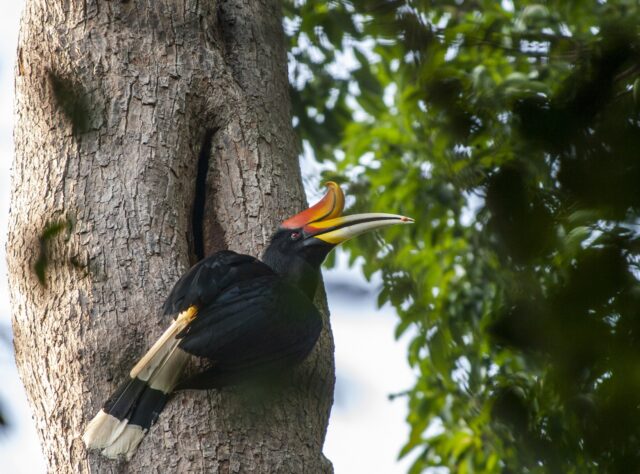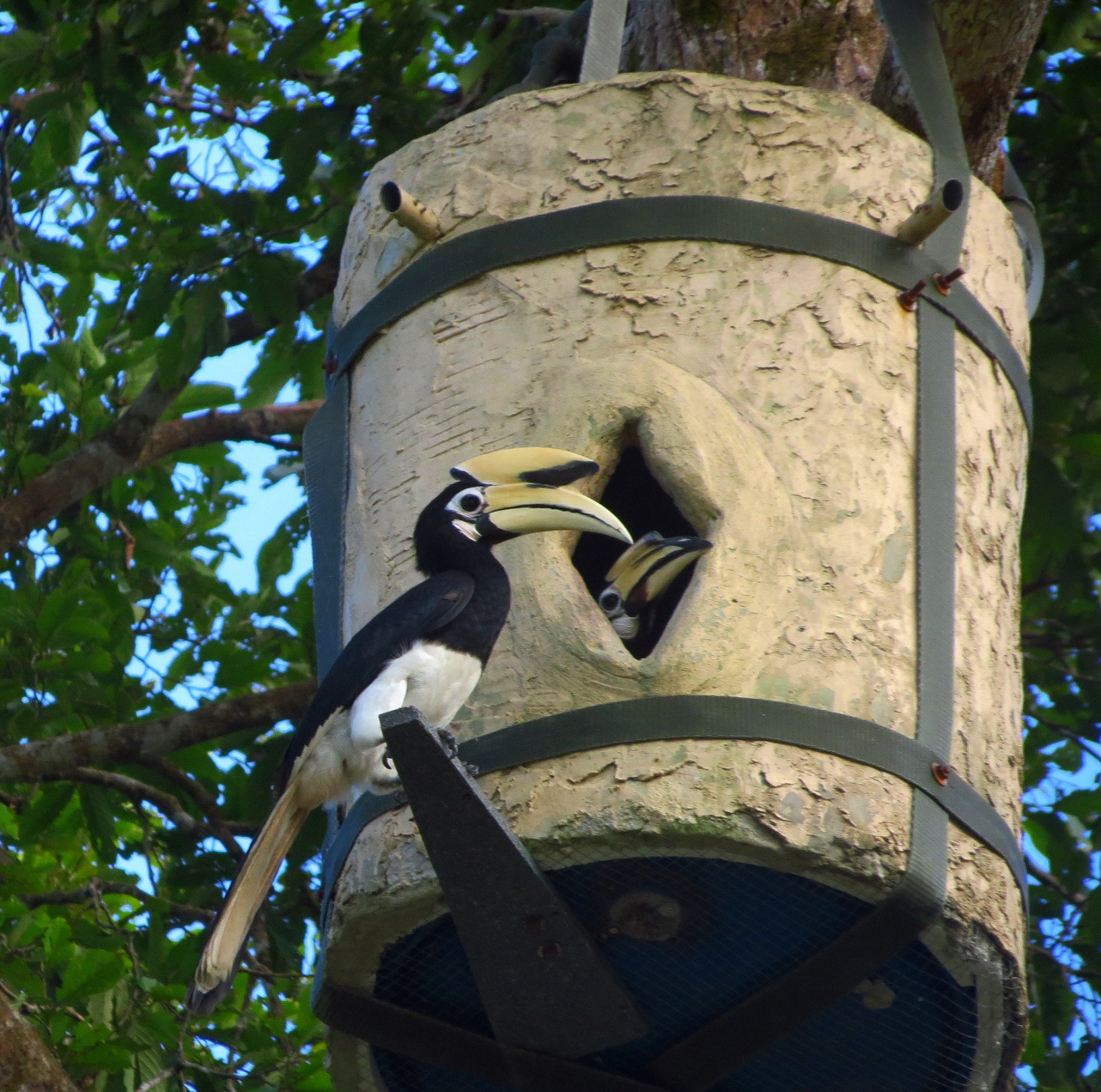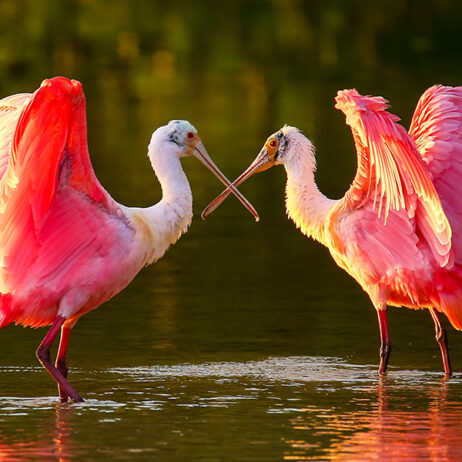
Borneo's hornbills nest in natural tree hollows like this one, but decades of deforestation have left the birds with a house-hunting dilemma. Credit: © SANJITPAAL SINGH / JITSPICS.COM
Orangutans might have become the worldwide symbol of what habitat loss and degradation are doing to Borneo, but this is also the home of astounding bird life. Supported by our ‘Saving Borneo’s Orangutan Corridors’ appeal, the saving of strategic plots of rainforest in Kinabatangan will allow our local partner to expand a critical nesting programme for eight hornbill species – a plan that World Land Trust (WLT) supporters can help make a reality by donating to our appeal.
Studying the life of Malaysian Borneo was what drew Isabelle Lackman to the island – and protecting it is what made her stay.
“My dream had always been to research Borneo’s wildlife, but when we arrived more than 20 years ago to the Kinabatangan Floodplain we realised that conservation issues were too pressing – if we didn’t do something there’d be no wildlife left to study,” Isabelle says of her co-founding in 1996 of conservation organisation HUTAN. “Since then, we’ve protected and restored these rainforests through land purchase and enlisted local women to plant thousands of trees. Wherever we look today, we see signs of how impactful this work has been; how key it is for it to continue.”
Continue the work must, because a history of deforestation at Kinabatangan has left behind a torn-apart landscape; islands of protected forest where wildlife faces a fate of genetic isolation. Having spent years safeguarding land for the Keruak and Pangi corridors, HUTAN can already save in 2021 two new plots of rainforest with the £150,000+ raised so far by our appeal. With the target now doubled to £300,000, our partner can go even further, purchasing and protecting more of these rainforests. If WLT supporters add their voice to our expanded appeal, we can save land home to not just 215 iconic mammal species such as Bornean Orangutan and Borneo Pygmy Elephant but also 314 bird species, including eight of Asia’s 10 hornbill species.
The Critically Endangered Helmeted Hornbill; the Rhinoceros Hornbill with their golden-yellow casque; the mohawk-sporting White-crowned Hornbill; the Black Hornbill, the Oriental Pied Hornbill, the Bushy-crested Hornbill, the Wreathed Hornbill and the Wrinkled Hornbill – Kinabatangan’s eight are a world of their own, and yet they all share an uncertain future if land protection does not continue at scale. Except for the Oriental Pied Hornbill, populations of all eight species across their entire distribution range are classed as Near-Threatened, Vulnerable or worse on the IUCN Red List.
“When we surveyed hornbill populations specifically at Kinabatangan we realised that some of them really are in trouble, and it largely comes down to lack of natural nests,” Isabelle explains. “These birds can live up to 30-35 years and because of such a lifespan, what we see is aging individuals with fewer places to breed. The big risk is once this generation dies the population will not replenish and that’s what we’re trying to avoid, through a nesting programme this campaign could help us expand to new patches of forest at Kinabatangan.”

The Helmeted Hornbill has long been hunted for its casque, the part of the bill known as “hornbill ivory”. Credit: © SANJITPAAL SINGH / JITSPICS.COM
A home fit for picky hornbills
For HUTAN, the first step was to assess the housing picture for Kinabatangan’s hornbills – an assessment, by extension, of the state of the landscape itself.
Because these birds are unable to dig out their own tree cavities they need the rainforest to provide natural ones – and provide the rainforest did, for as long as humankind allowed it. In Malaysian Borneo, the intensive logging for timber decades ago decimated the floodplain’s primary forests; the big, living trees and the natural hollows that new generations of hornbills depend on. When HUTAN gauged nest availability in the secondary forest that stands today instead, they found there were too few suitable options left. It was time to intervene.
To give hornbills a home they would use, HUTAN had to adapt its thinking to these birds’ remarkable home-making habits. The females that are sealed into the nest to incubate the eggs need large, ventilated spaces, while the males that forage and pass on food through a small entrance need a branch to stand on. “And these birds can be picky,” Isabelle points out. “For instance, male Rhinoceros Hornbills will perch below the cavity to feed the female from there, while other species prefer a branch on top of the cavity. So you need a hollow, but also the right place for the male to sit.”

HUTAN have installed a total of 18 nestboxes, some as high as 100 ft off the ground! Credit: HUTAN
With this hornbill wishlist in mind, HUTAN partnered with Dr Ravinder Kaur – a Malaysian hornbill researcher who later founded her own NGO, Gaia – and together they opted for a two-pronged approach. First, they looked at how natural cavities in Kinabatangan’s forests could be retrofitted, with field visits leading to improvements including larger hollows, nest floors with better grip and trunk add-ons for males to perch on. Next came artificial hornbill nests: having heard of pilot schemes in Thailand, the HUTAN team was inspired to go down this route. As Isabelle explains, Dr Kaur carried out tests to ensure all aspects key to nest design – temperature and humidity are the most crucial, size aside – added up to the perfect hornbill home.
Getting there required a fair bit of fine-tuning but HUTAN is already seeing positive results from the latest iteration, a marine plywood prototype coated with expanded polystyrene foam for insulation and fiberglass for weather endurance. “We’ve had artificial nests being used by Rhinoceros, Bushy-crested and Oriental Pied Hornbills and we’ve even seen young fledglings,” Isabelle explains. “Now that this programme has been successful, we want to expand it. With support from donations to this campaign, the two properties we can now secure at Pangi are a start, and our goal is to continue saving land – reconnecting the landscape and restoring the network of nests that hornbills once enjoyed in the Kinabatangan Floodplain.”

Oriental Pied Hornbills were the first species to take a liking to HUTAN and Dr Kaur’s design. Credit: HUTAN
Rescuing Borneo’s birds from a conservation ‘breaking point’
Much like everyone else, humans included, the life of Borneo is having to adapt to 2021’s reality of a fragmented, degraded natural world. Kinabatangan’s orangutans are, according to HUTAN, changing their diet and learning to be less territorial with each other to weather the shift to smaller, crowded forest patches.
For hornbills, the adjustment is no less steep and artificial nests can only go so far. As Isabelle points out, Kinabatangan remains a landscape “at breaking point” despite the progress seen so far with HUTAN’s land purchases and talks with plantation owners to secure safe passage for wildlife. In the long run, the only option is to double down on these proven solutions, and drive them at scale. Some, like the Helmeted Hornbill, sorely need this conservation push to succeed in Kinabatangan and beyond: its range-wide populations are classified as Critically Endangered and Decreasing, and sightings of pairs within HUTAN’s target area remain very rare.
But if some of Kinabatangan’s bird residents lie on the brink, they can be brought right back through HUTAN’s tried-and-tested approach since 1996. “We know how impactful conservation action can be because we’ve seen its results over the decades: the 460 acres we have already saved at the Keruak Corridor, the 150 or so acres we can save in total across the river at Pangi, the 52,000+ trees our Indigenous restoration team has planted in the area,” Isabelle says. “Hornbills, swiftlets, primates, local people – a better future is possible for the rainforests of Kinabatangan. Let’s create it together!”

